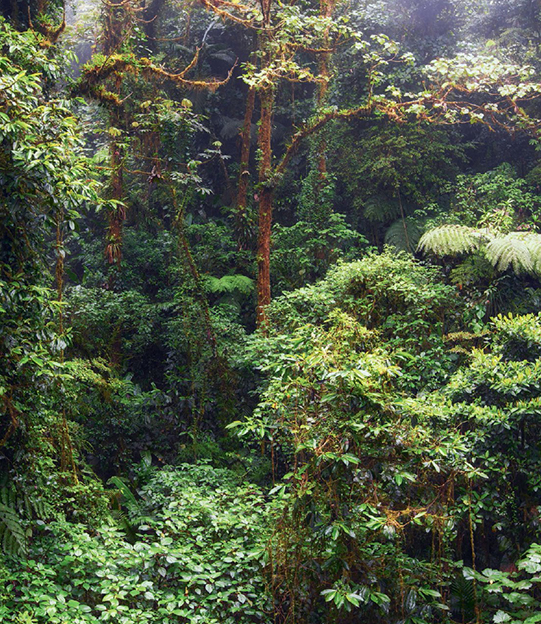1973
Tropical Rain/Cloud Forests
The Earth’s ten or so major kinds of ecological community types or biomes are not randomly distributed across the surface. Rather, they strongly correlate with other factors, including elevation, proximity to the ocean, proximity to major mountain ranges, and, perhaps most importantly, latitude. At low latitudes near the equator, sunlight is most intense and precipitation is heaviest; at high latitudes near the poles, it is coldest and driest.
Tropical rainforests occur exclusively in those equatorial regions of the greatest heating and rainfall, and as a result exhibit the highest density of plant growth and the highest diversity of species of any of the biomes on Earth. By definition, a tropical rainforest is a place where it rains at a roughly constant (and high) rate all year round—there is no “dry season” like in many other biomes. A closely related class called cloud forest is a biome that extends to subtropical latitudes where temperatures are hot but slightly cooler and rainfall is still abundant and continuous. Cooler temperatures and often slightly higher elevations lead to nearly continuous ground fog, which is where cloud forests get their name.
Tropical rainforests and cloud forests are constantly at risk for unsustainable human exploitation because of their enormous resource potential (wood, minerals, game) and the difficulty of monitoring and managing such huge expanses of wild terrain like the Amazon. An important milestone in the realization of the importance of these places was the establishment, in 1973, of the Monteverde Cloud Forest Reserve, in the western Cordillera de Tilarán mountains of Costa Rica, about 10° north of the equator. Monteverde is a privately funded 26,000-acre nature preserve that is estimated to contain over 2,500 species of plants, 100 species of mammals, 400 bird species, 120 species of reptiles and amphibians, and thousands of species of insects, all in an area only about the size of Walt Disney World in Florida.
The success of Monteverde (more than 70,000 people visit each year) attests to widespread interest in the preservation of unique places like rainforests and cloud forests. Dozens of public and private preserves and national parks now aim to protect as many of these hot, wet, and wild places as possible around the world.
SEE ALSO Sahara Desert (c. 7 Million BCE), Amazon River (1541), Deforestation (c. 1855–1870), Angel Falls (1933), Temperate Rainforests (1976), Tundra (1992), Boreal Forests (1992), Grasslands and Chaparral (2004), Temperate Deciduous Forests (2011), Savanna (2013)
A 2013 photo taken of lush jungle flora deep within the Monteverde Tropical Rainforest Preserve in Costa Rica.
